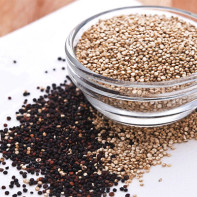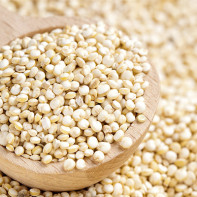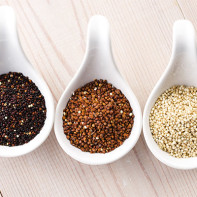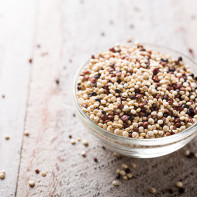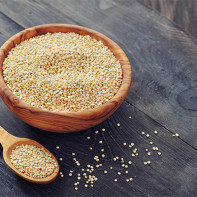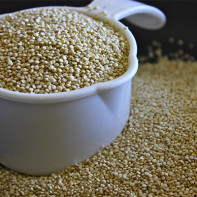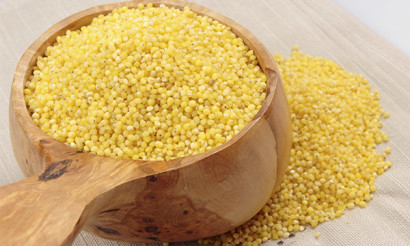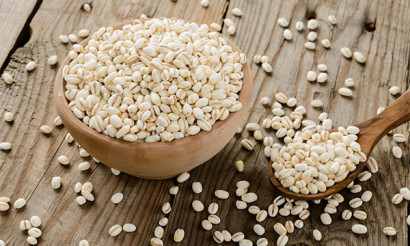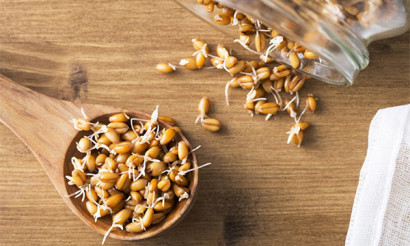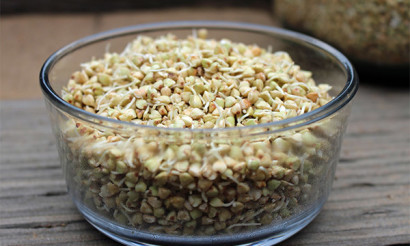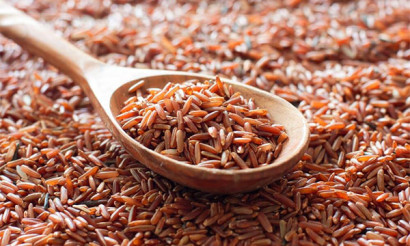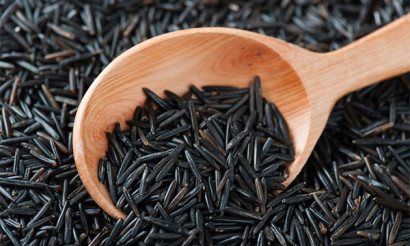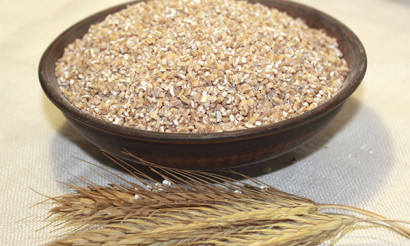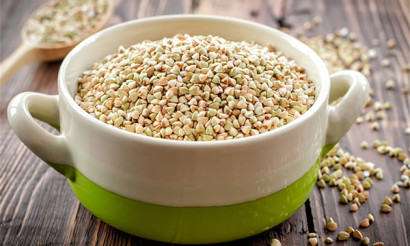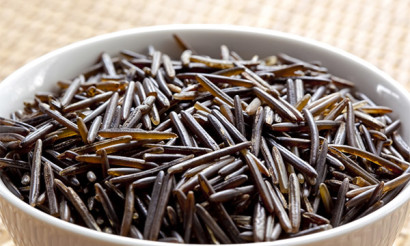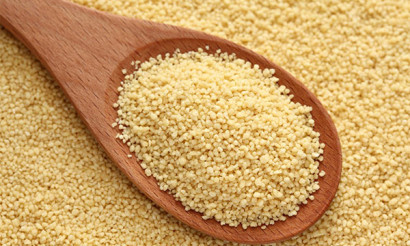Krupa quinoa: benefits and harm to the body
Many have heard of quinoa, which is often called super-eating. We offer you to learn in detail about its advantages that have been recognized in the health circles for quite some time, but have attracted the attention of the media only in the last few years.
- What is quinoa
- Composition and calorie content
- Useful properties of quinoa groats
- How old is quinoa for children?
- The benefits and application of quinoa for weight loss
- Quinoa in medicine
- With diabetes
- With pancreatitis
- For gastritis and intestines
- With gout
- Quinoa groats in cosmetology
- The benefits and uses of quinoa flour
- How to choose flour
- Culinary use of quinoa flour
- How to store quinoa flour
- Health Benefits of Quinoa Flour
- Harm and contraindications
- How to choose and store quinoa
- How to cook quinoa: recipes
- The healthiest way to make quinoa
- Recipe for baby food: quinoa porridge
- Grilled Salmon with Coleslaw and Quinoa Salad
- Interesting Quinoa Facts
What is quinoa
This grain has become popular among health-conscious people due to its various benefits, including a large amount of protein, fiber, vitamins and minerals. It is rich in magnesium, iron, B vitamins, calcium, potassium, phosphorus, vitamin E and various antioxidants. Gluten free and recommended for people who are on a gluten free diet.
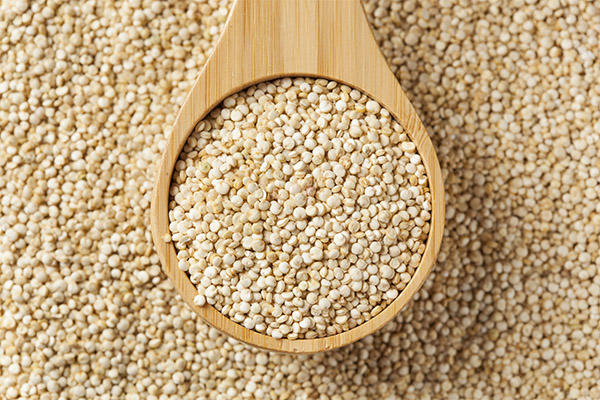
Quinoa is a grain crop grown mainly due to edible seeds. This plant is a species of the genus goose paw (Chenopodium quinoa), which appeared in the Lake Titicaca region of Peru and Bolivia. Domestication dates back to 3-5 thousand years BC, when the peoples of America began to breed it according to existing historical data. In addition, there are archaeological evidence of quinoa in the tombs of Arica in Chile, Tarapaca, Calama and in various regions of Peru. At that time, pre-Columbian civilizations grew and used quinoa as their staple food.
The most common types include white, red, and black quinoa. In addition to the uniqueness of color, various varieties give their tastes and textures. White quinoa is the most common, with a smoother texture than red quinoa, which is most often used in cold salads. Black quinoa is slightly earthier and sweeter than soft white.
Composition and calorie content
The calorie content of quinoa is 368 kcal per 100 grams of product.
Fats are found in small amounts. It is polyunsaturated and monounsaturated.
Quinoa is a complete protein, accounting for about 8 grams per serving. High-grade proteins are those that contain all 9 essential amino acids.
Quinoa is gluten-free, protein rich and one of the few plant foods that contains all 9 essential amino acids. Quinoa is also rich in fiber, magnesium, B vitamins, potassium, calcium, iron, phosphorus, vitamin E and various beneficial antioxidants. Some types, known as phytoestrogens, are being studied in the treatment of menopausal symptoms because they sometimes have the ability to behave like estrogens in the body.
By incorporating quinoa cereal into your diet, you will undoubtedly increase your overall intake of these nutrients, as well as other important plant components.
Unlike many cereals, quinoa is very rich in fiber. In one study at the University of Valencia in Spain, 4 varieties of quinoa were used to determine the amount of fiber. On average, it turned out from 10 to 16 grams of fiber for every 100 grams of cereal.
This grain does not contain GMOs and is usually grown organically.
Useful properties of quinoa groats
Low sodium quinoa is rich in fiber and protein. Fiber is a non-digestible portion of carbohydrates that helps saturate the body and relieve hunger.Porridge from this cereal prevents and relieves constipation, can help lower cholesterol, which is good for the heart. Indicated for maintaining a stable blood sugar level.
Studies show that the risk of type 2 diabetes is lower with frequent use of whole grains. An alternative to pasta to satisfy starch cravings.
Quinoa porridge will be useful for athletes. Muscles need not only protein to function and grow normally, but also other nutrients like iron, which also helps maintain healthy muscle metabolism.
Quinoa for breastfeeding and pregnancy
Due to the high content of nutrients, quinoa is recommended for women during pregnancy. Croup will fill the body with vitamins and minerals, as well as help restore strength, reduce appetite, and avoid anemia.
When breastfeeding quinoa is recommended for use to produce milk and saturate it with nutrients. Since the cereal from this cereal does not contain gluten, the possibility of an allergic reaction to this dish is minimized.
How old is quinoa for children?
It is not recommended to feed quinoa to children under 2 years of age, despite all its advantages. Croup contains saponins, which are toxic to babies and irritate the intestines. After 2 years, you can add porridge from this cereal to the diet.
The benefits and application of quinoa for weight loss
Quinoa today is a trend in healthy food, and it has become one of the main ingredients in the diets of many health-conscious people. And this is not surprising: porridge from this cereal gives a feeling of satiety for a long time, has a neutral taste. Also, cereal contains some nutrients that can help lose weight, so it is a useful addition to weight loss diets, the main thing is to monitor the serving size.
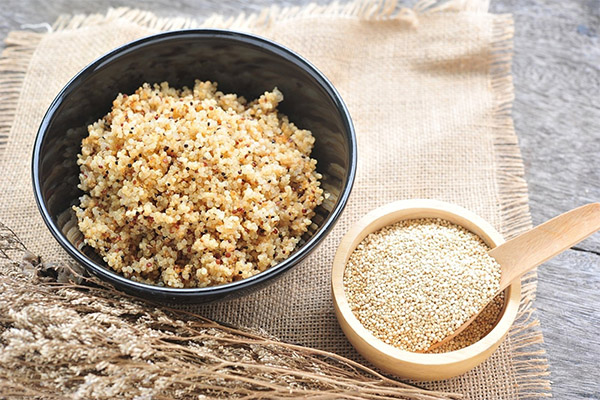
Evidence for the effectiveness of quinoa for weight loss is clear.
- There is some preliminary evidence directly linking quinoa to weight loss. One study published in the journal Food Science and Technology in 2015 examined the effects of quinoa on appetite in laboratory rats. The study authors found that rats fed quinoa grits generally ate less food than rats that did not eat grits.
- Other studies show that 20-hydroxyecdysone, one of the compounds found in quinoa, can help in weight control. One animal study published in the journal Psychology and Behavior found that mice fed quinoa extract with a high content of 20-hydroxyecdysone burned more calories during the day and consumed less fat from their diet.
Another study published in 2012 on obesity found that mice fed quinoa extract with a high content of 20-hydroxyecdysone are less likely to gain weight on a high-fat diet than mice that did not receive the extract. Although this study is promising, it’s too early to say whether quinoa is as beneficial to people.
If you want to lose weight deliciously, you can serve quinoa, topped with a nutritious pesto of mixed cabbage, almonds and olive oil, for a healthy side dish filled with herbs. Or make quinoa salad for lunch by mixing it with stewed zucchini, sweet peppers, onions, mushrooms, eggplant and homemade vinaigrette with lemon and basil.
Quinoa in medicine
With diabetes
To keep blood sugar levels at the right level, diabetics must be consistent and careful about dieting. If you do not pay attention to your diet, then you can easily raise blood sugar and eventually face serious and dangerous complications of the disease.
Quinoa kernels are ideal for diabetics with their eternal chronic fatigue. This cereal is characterized by a low glycemic index (53 units). This means that porridge will not increase the blood sugar level of a diabetic.Quinoa also contains a large amount of magnesium, which is known to help patients with this disease. A study published by the American Diabetes Association shows that oral magnesium supplementation improves insulin sensitivity and metabolism in patients with type 2 diabetes. Hypomagnesemia is a condition in which the level of magnesium in the blood is low. This condition is common among diabetics. Although such supplements are controversial and should be prescribed by a doctor!
With pancreatitis
Diet for chronic pancreatitis is the number one strategy recommended for patients with a diagnosis of inflamed pancreas. Pancreatitis is more common in adults due to alcohol abuse, due to the development of gallstone disease, but childhood pancreatitis is not uncommon due to many genetic factors and malnutrition.
A pancreatitis diet plan is aimed at combating a deficiency of digestive enzymes and insulin in some cases. A diet for chronic pancreatitis should include 4-5 small and frequent meals throughout the day. Alcohol, tobacco, sodas, fruit juices and caffeinated drinks are highly undesirable, as they tend to over-stimulate the pancreas.
Complex carbohydrates, which are in quinoa, are acceptable for chronic pancreatitis - porridge is used 1-2 times a week with the addition of extra virgin olive oil. A dish from this cereal has an enveloping effect that promotes the assimilation of food, while not irritating the gastric mucosa.
In the acute form of pancreatitis, quinoa is not worth consuming.
For gastritis and intestines
People with acute gastritis should give up quinoa, since you can not use it with an exacerbation. When the disease is chronic and does not bother the symptoms, grains are permissible in the diet 3 times a week.
Quinoa is usually cooked for 7-8 minutes - this cooking time is suitable for a healthy person. Nevertheless, for a patient with gastritis, porridge should be more cooked to become viscous in order to envelop the inner walls of the stomach. It is the viscosity of porridge that is necessary for the treatment of gastritis. Undercooked quinoa can only exacerbate the disease. Instead of quickly digesting food, the stomach will be loaded, trying to extract the necessary amount of acid to digest food.
Quinoa does not cause gastrointestinal upsets. However, do not abuse this crop.
With gout
Quinoa should not be used for gout and acute phases of urolithiasis.
Quinoa groats in cosmetology
The International Journal of Dermatology has discovered that zinc, which is found in quinoa, plays an auxiliary antioxidant role in protecting against oxidative damage caused by free radicals. Zinc protects against ultraviolet radiation and improves wound healing. Researchers have concluded that zinc ions can provide important and beneficial antioxidant protection for the skin. It is used for cosmetic purposes, quinoa oil, which has a healing effect, and also smoothes the skin and removes small wrinkles.
Beauticians also use quinoa as a scrub to combat cellulite.
The benefits and uses of quinoa flour
Flour is made by grinding quinoa grains into smaller particles. Color - from cream yellow to ivory. There are various types, such as red and black quinoa, but white is most often used.

Quinoa flour is very expensive, so people buy whole grains in bulk and turn it into flour on their own, grinding at home in a food processor or in a mill in accordance with their requirements. Such flour is a safe option for those who cannot tolerate gluten.
How to choose flour
- Read the label, make sure that it says “quinoa flour”, and also check the expiration date.
- Inspect the packaging for damage.
- If the packaging is transparent, you should look inside to see if the flour is really yellowish or cream in color, and it should also be crushed as much as possible. Flour should not look lumpy.
Culinary use of quinoa flour
- Such flour is used to make gluten-free bread and other bakery products such as pancakes, muffins, pizza base, crusts for pies, etc.
- Commonly used in combination with other flour.
- It can be used for thickening sauces, soups, etc.
How to store quinoa flour
- Store in an airtight container.
- Some people also store quinoa flour in the refrigerator, in an airtight container, or freeze it to use if necessary.
Health Benefits of Quinoa Flour
- Weight Loss: The high fiber content of quinoa is the main nutrient that helps to reduce weight. Dishes prepared with such flour have a high protein content, which additionally helps to increase our metabolism and reduce appetite. Decent weight loss is achieved with regular use of quinoa and the abolition of baked goods made from ordinary wheat flour.
- Blood sugar control: Quinoa with a low glycemic index of 53 is considered a safe product for diabetics. Foods with a low glycemic index do not contribute to a rapid increase in blood sugar, which helps to combat an insidious disease.
Harm and contraindications
- Quinoa is contraindicated in case of individual intolerance and with kidney problems, people with urolithiasis and gout.
- Do not give quinoa porridge to children under 2 years old.
How to choose and store quinoa
White quinoa is the most common type of grain that you will find in most stores, although red and black are also becoming available in large cities. As for the choice of cereals, there is one single rule: check the expiration date indicated by the manufacturer on the package and its integrity.
It is better to store quinoa in an airtight container made of glass or plastic: in this case, the cereal will be stored for a longer period, from about 3 to 6 months.
How to cook quinoa: recipes
Whatever dish you cook from this cereal, it must first be thoroughly washed under running water. This will save the grain from dust, and also remove the possible aftertaste of bitterness that may appear after boiling the porridge.

The healthiest way to make quinoa
To make quinoa, add one part grain to two parts water in a pan. After the mixture is brought to a boil, reduce the temperature, simmer and cover. It usually takes 15 minutes to prepare one cup of quinoa using this method. When cooking is done, the grains will become transparent, and the white germ will partially detach, looking like a white spiral tail.
If you want quinoa to have a more nutty flavor, you can fry it before cooking. You need to place it in a pan (stove over medium heat) and stir constantly for 5 minutes.
Recent studies on the preparation of quinoa have compared steaming techniques to evaluate the effect of food processing on vitamin B. The good news is that folic acid in cereals appears to be well preserved by any cooking method.
Quinoa flour is another product that is becoming increasingly available in supermarkets. Although baked goods and pasta can be made from 100% quinoa flour, many companies that produce products from this substance combine it with other types (for example, tapioca flour, rice or even oatmeal) to obtain a lighter texture. Making baking at home, you can experiment.
Recipe for baby food: quinoa porridge
Ingredients:
- 1 cup whole quinoa (unground).
- 2 glasses of water.
Cooking:
- In a large saucepan, bring 2 cups of water to a boil.
- Add 1 cup quinoa.
- Cover the pot, reduce heat and simmer for about 15 minutes. Let stand for five minutes.
You can add spices such as cinnamon, ginger and vanilla, as well as fruits, vegetables, or other products appropriate for the age of the child.
Grilled Salmon with Coleslaw and Quinoa Salad
Ingredients:
- 1 salmon fillet - approximately 500 grams;
- 1 teaspoon of olive oil;
- 1/8 teaspoon of salt;
- 1/8 teaspoon freshly ground black pepper;
- 2 cups thinly sliced cabbage lacinato;
- 1/2 cup cooked quinoa.
How to prepare the dish:
- Preheat oven to 320ºC.
- Put salmon on a baking sheet covered with foil. Grind evenly with oil, salt and pepper. Bake at the temperature indicated above for 10 minutes until the fish begins to peel off easily when tested with a fork.
- While the fish is cooking, mix the cabbage, quinoa, universal citrus dressing and grapes in a bowl. Let stand for 5 minutes. Put salmon on top.
What else can you cook with quinoa
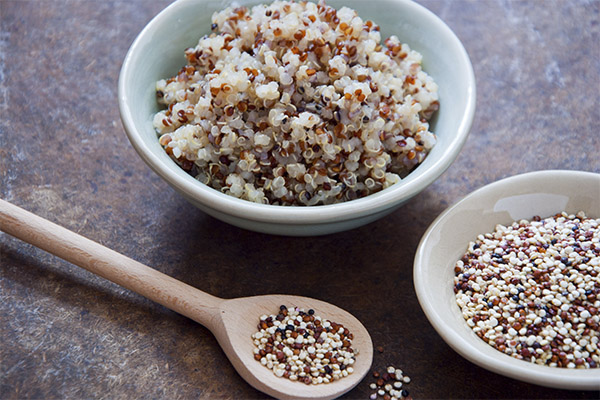
- Meat pilaf. According to the traditional scheme, we prepare a rich broth from any meat (800 g), onion-carrot frying, spices (coriander, zira, barberry, etc.). In 10 minutes add tomato paste or tomatoes, add 2 cups of seeds and add water so that it rises 1.5 cm above the mass. Cover and simmer for 30 minutes.
- Vegetable side dish. Boil 200 g of seeds in salted water. Fry in oil 2 zucchini, a couple of carrots, 1 head of red onion and a stem of young celery. Combine vegetables with porridge and season with sauce (100 ml of citrus fresh juice + paprika).
- Canapes with fish. Take 40 g of cereal and boil until tender. Cut the baguette into slices and fry them in butter. Mix boiled seeds with chopped pickled herring or mackerel (50 g) and a piece of butter. Put the resulting stuffing on croutons, garnish with fresh cucumber and a sprig of greens.
- Energy breakfast. Steam a couple tablespoons of coconut flakes. Boil the extracted milk, combine with spices (vanilla, cinnamon) and add 100 g of quinoa seeds. When the porridge has absorbed all the liquid, add the dried fruits, cover and simmer for 5 minutes. Before serving, you can decorate with a banana.
- Vegetarian salad. Boil a glass of seeds. Also separately cook 10 stalks of asparagus, chop it into pieces. Dice 1 grapefruit. Combine the ingredients and season with the sauce (4 tablespoons of olive oil, fresh half a lemon, salt and pepper, chopped greens).
Interesting Quinoa Facts
Despite its growing popularity, most people do not know much about this ancient grain. Here are some fun facts about the popular superfood.
- Quinoa is not really a grain. We cook and eat quinoa, like many other cereals, but from a botanical point of view, it is a relative of spinach, chard and beetroot. The part we eat is actually a seed. Its leaves are also edible.
- Quinoa is a complete protein. Back in 1955, the study confirmed the nutritional properties of the culture.
- There are about 120 known types of quinoa. Commercial are white, black and red.
«Important: all information on the site is provided exclusively in fact-finding purposes. Before applying any recommendations, consult with a profile specialist. Neither the editors nor the authors are liable for any possible harm caused materials. "

